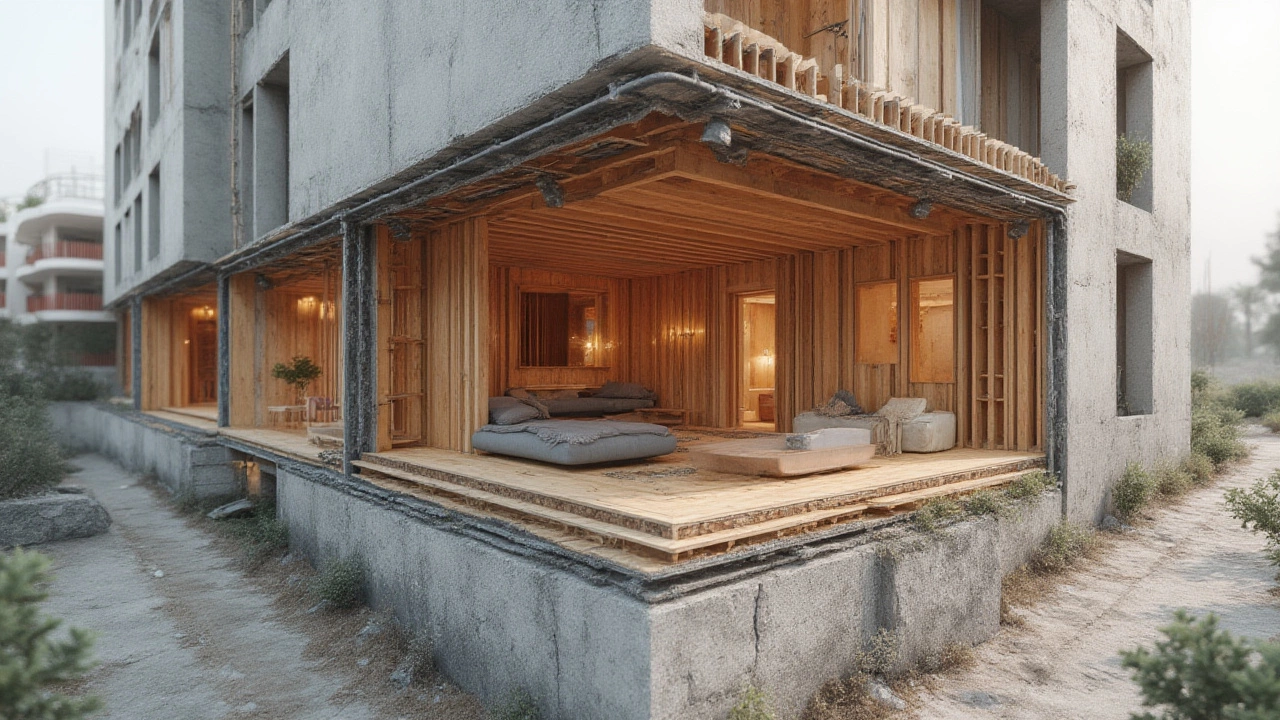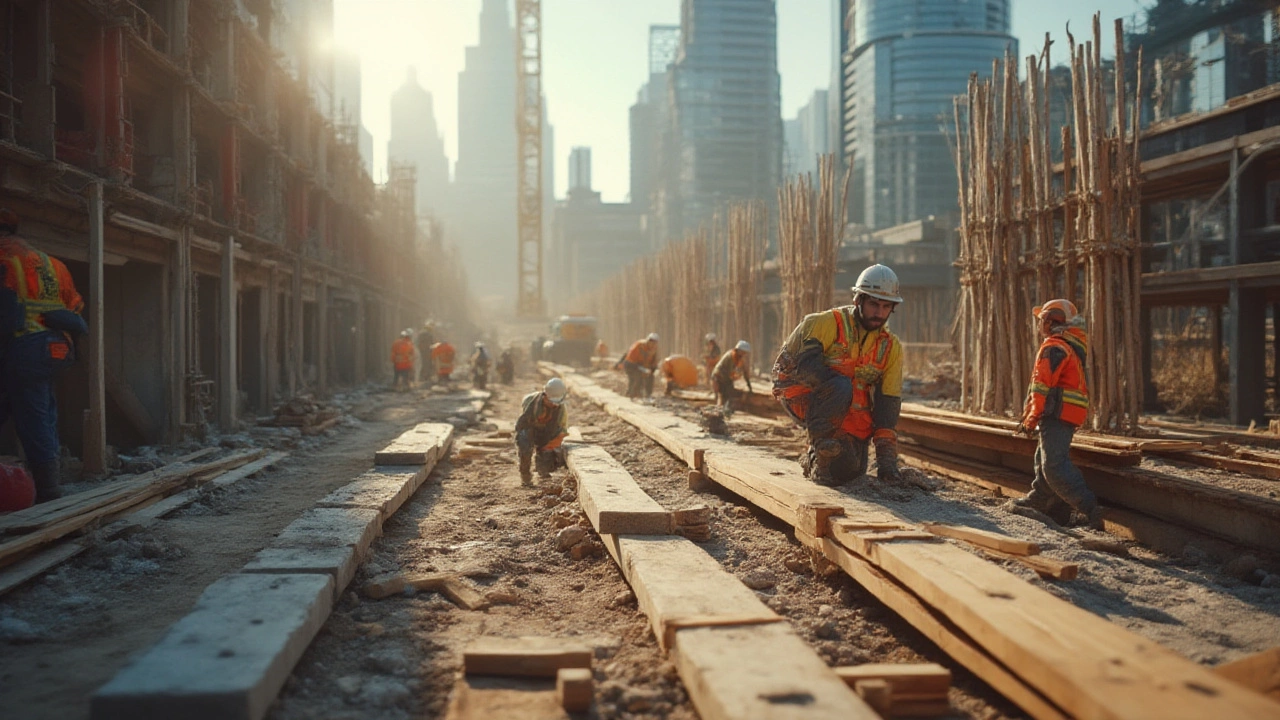Walk past any building site and you’ll notice that most of the action revolves around three main ingredients: concrete, steel, and wood. Big projects, new homes, clever renovations—these materials never go out of style. But what is it about concrete, steel, and wood that keeps them at the heart of the construction world? Digging into this question uncovers a surprising mix of history, science, and pure practicality.
Why Are Concrete, Steel, and Wood So Popular?
There’s a reason architects and builders keep coming back to these materials. Concrete handles almost anything you throw at it: roads, bridges, skyscrapers, even garden paths. It’s strong, especially when reinforced with steel, and can be shaped into just about anything. Then there’s steel. It shows up everywhere you look, from the beams inside a shopping mall to the skeleton of a stadium. Builders love it because it’s sturdy, works well with other materials, and has a remarkable strength-to-weight ratio. Wood, on the other hand, has ancient roots. It’s renewable, easy to work with, and gives off that cozy, natural feel you just can’t replicate with metal or stone.
These materials aren’t just practical—they shape how our cities look and feel. Concrete lets architects get creative with sweeping curves or high towers. Steel means we can build higher and more daring than our ancestors ever dreamed. Wood brings warmth to homes, offices, and even giant sports arenas. Each one plays its part in the personality of a place. Walk around New York, London, or Tokyo and you’ll spot their fingerprints on every block.
Still, choosing the right material isn’t just about aesthetics. Builders need to think about durability, weight, cost, climate, and even how easy it’ll be to find replacements in 40 years. For example, wood might not be the best choice in termite country unless you know your treatments. And while steel’s corrosion resistance is legendary, salt air near the coast can still wear it down unless you’re careful with coatings or alloys.
It’s tough to imagine modern life without these materials. Concrete highways let us zip across countries. Steel makes it possible to have open floor plans in our homes. Wood shows up in everything from the frame of your house to the shelves in your kitchen. They might be everywhere, but each one offers something different, and sometimes—when mixed together—produce results no single material could deliver.
The Mighty Concrete: Building Block of the Modern World
Talk about a superstar. *Concrete* is the backbone of modern construction—quite literally. It’s a simple mix: stone, sand, water, and cement. But it’s the chemical reaction that happens when water meets cement (known as hydration) that turns this muddy mixture into something so strong it can last centuries. The Romans figured this out more than 2,000 years ago, and some of their concrete structures are still standing. What makes modern concrete even more useful is reinforcement: steel bars (rebar) are added to handle stress, so you end up with a material that’s hard to crush and hard to pull apart.
The scale of concrete use is mind-blowing. The world churns out more than four billion tons of cement every year, which means humanity pours enough concrete each year to build a wall 27 meters high and one meter thick—around the planet. Concrete’s popularity is hardly surprising. It’s fire-resistant, water-resistant, and even earthquake-resistant if you use the right mix and design. Imagine building a dam or a tunnel without it. Not going to happen. The reason we have such bold city skylines, smooth highways, and even sturdy countertops inside homes? Mostly, it comes down to concrete’s flexibility and raw strength.
Concrete is customizable, which makes it perfect for all kinds of jobs. Add chemicals called admixtures, and you get concrete that sets faster, flows more easily, or resists freezing. Want colored concrete for a polished floor? Done. Need concrete that’s lighter for a rooftop garden? Use lightweight aggregates. Feeling eco-friendly? Partly replace cement with fly ash or slag, industrial byproducts that cut down on carbon emissions. Just one tip: fresh concrete needs care. Curing it slowly with moisture stops cracks and boosts its strength. Ignore this, and you’ll pay in repairs later.
Of course, concrete isn’t perfect. Making cement—the main ingredient—causes a lot of CO2 emissions. Builders and scientists are working to shrink that carbon footprint by recycling old concrete, using alternative materials, or developing low-carbon cements. Still, as long as people want safe roads, solid foundations, and dramatic cityscapes, concrete isn’t going anywhere.

Steel: The King of Strength and Flexibility
If concrete is the brawn, steel is the skeleton. Steel’s reign in construction started with the Industrial Revolution, when rolling mills churned out beams and columns that changed the world. The reason steel is everywhere has everything to do with its mix of strength, flexibility, and the ability to hold up under load. That’s why skyscrapers are made of steel—they need to sway in the wind, not crack apart. Bridges spanning rivers, stadiums with wide-open roofs, even the domes over airports—all possible because of steel’s special blend of toughness and ductility.
Let’s talk about the perks. Steel structures go together fast, sometimes in just weeks. The parts are made offsite with laser precision, then bolted or welded together on location. It’s like a giant, high-stakes set of building blocks. This speeds up big projects and cuts down on waste. Plus, steel’s light compared to concrete, so you can use thinner foundations and still get the same strength. With the right coatings, it’ll laugh off rust and last decades even in rough conditions.
Here’s where science comes in: steel is an alloy, mostly iron with a dash of carbon and other elements depending on the purpose. Stainless steel, for example, resists rust thanks to added chromium. Weathering steel (like the kind you see on some bridges) forms a tough, rusty-looking layer that protects it from further damage. There’s even steel mesh built into concrete for extra muscle. It also scores points for being recyclable—steel from an old building often finds a second life in new projects, and it can be recycled endlessly without losing strength.
Still, steel has its quirks. It’s vulnerable to heat, so in a fire you need to insulate it or use special coatings. It can corrode in salty air or if two different metals touch in the wrong way. And steel isn’t great at holding in heat or blocking noise, so it’s usually combined with insulation and other materials. Engineers stay busy figuring out how to balance all this—whether they’re designing lightning-resistant roofs or flexible bridges that won’t snap in an earthquake.
For folks considering steel in a new build or renovation: don’t skimp on maintenance. Regular inspections, rust-proofing, and attention to connectors mean steel will outlast just about anything else you could use. And when you’re done with it? Just recycle.
Wood: The Renewable Original
Wood might seem old-school, but it’s having a major revival. Builders love it for speed, cost, and that clean, welcoming vibe you get from exposed beams and floorboards. No surprise, since people have been building with wood for thousands of years. What’s changed is how we use it now—from towering timber-framed buildings to engineered products like plywood and cross-laminated timber (CLT) that make wood stronger, more predictable, and easier to use than ever.
Wood is light but strong, easy to cut and shape, and available pretty much everywhere. In North America and Europe, most homes—especially those outside cities—still use wood framing. These aren’t the log cabins of old. Think sophisticated layouts with advanced engineering that handle heavy loads and resist earthquakes. Engineered woods like LVL (laminated veneer lumber) let builders span large open spaces without chunky beams. And because trees soak up carbon when they grow, wood has a much smaller carbon footprint compared to concrete or steel, especially if responsibly sourced.
But there’s more: wood’s natural ability to regulate humidity makes places feel more comfortable. It absorbs and releases moisture, which helps keep your home’s climate in check. Wood also insulates better than concrete or steel, so you won’t have to blast the heater as often in a cold snap. And let’s not forget repairs—fixing or adjusting a wooden structure is usually easier than with other materials. A warped board or dented panel can often be replaced without much fuss.
Of course, there are trade-offs. Wood can rot, termites can snack on it, and fire is an ever-present risk. But modern treatments go a long way. Pressure-treating adds resistance to bugs and moisture, while new coatings slow flames and keep buildings safe for longer. Some of the tallest wooden structures today reach over 80 meters, showing just how far wood technology has come. Builders already dream of 100-meter towers rising out of cross-laminated timber—a reminder that the oldest material in the book isn’t standing still.
If you’re thinking about using wood, look for certification from organizations like the Forest Stewardship Council (FSC). That guarantees your lumber is coming from forests that will be around for generations. Pairing wood with smart design and regular upkeep can give you something both classic and cutting-edge, whether you’re upgrading a kitchen or putting up a new building on the block.

Choosing the Right Material for Your Project
Picking the right building material is never just a checklist. It’s more like a balancing act between performance, price, looks, and what the project actually needs. Some climates scream for concrete—think hurricane zones or floodplains—while steel shines in places where you need big, open indoor spaces. Wood fits where budgets are tighter, where local codes encourage renewable materials, or where people just crave that natural look.
If you want durability, ask about the expected lifespan of your material and what maintenance looks like down the line. Concrete can last over a hundred years if mixed and cured right. Steel, properly protected, does fine for decades. Wood, cared for and chosen wisely, can surprise you. But there’s always upkeep. Concrete needs to be sealed and crack-checked. Steel needs watchdogs for rust, especially at welds and bolts. Wooden structures want routine checks for rot or pests. Cutting corners here just means bigger bills later.
Energy efficiency matters too. Wood naturally insulates, but concrete walls, especially new high-tech versions, are now packed with insulation layers that stop drafts cold. Steel needs help here, but clever builders add spray foam, batts, or panels to keep cold or hot air at bay and lower those energy bills.
There’s also the sustainability angle. Concrete’s biggest challenge is its carbon footprint, but big concrete companies are rolling out products with less cement, recycled content, and carbon capture tech. Some construction sites crush old concrete into new gravel. Steel’s constant recyclability is a game-changer, making it a favorite for those who want something that outlives even the building itself. With wood, it’s all about responsible forestry and advanced engineering, creating massive beams from fast-growing trees and slashing waste in the process.
Thinking long-term can really pay off. For example, choosing materials that are locally available cuts transport costs and emissions. Using a combination of concrete, steel, and wood lets you play to each material’s strengths: concrete for foundations and floors, steel for open-plan frames, wood for walls, roofs, or finishes. Each decision shapes not just your building but its impact on its surroundings years down the road.
So, the next time you see a new apartment block rising, notice the blank slab of concrete, the shimmer of a steel beam, and the warm lines of wood finishing. These three materials aren’t just tools—they’re the reason modern life looks and works the way it does. Picking wisely means better spaces, happier occupants, and a building that’ll stand the test of time—and maybe even make the next round of history books.

Author
Damon Blackwood
I'm a seasoned consultant in the services industry, focusing primarily on project management and operational efficiency. I have a passion for writing about construction trends, exploring innovative techniques, and the impact of technology on traditional building practices. My work involves collaborating with construction firms to optimize their operations, ensuring they meet the industry's evolving demands. Through my writing, I aim to educate and inspire professionals in the construction field, sharing valuable insights and practical advice to enhance their projects.